Table of contents
Getting Started with Sales Orders
Monday February 26, 2024-18 min readIntroduction
A sales order is a seller’s response to a customer’s purchase, confirming sale details and indicating intent to fulfill the order. Its primary purpose is to communicate order specifics to internal fulfillment departments. This guide will cover how you can use the Sales Orders app to efficiently manage sales orders, link contacts, sales reps, commission schedules and approvals. It documents order details for seamless, transparent transactions with customers.
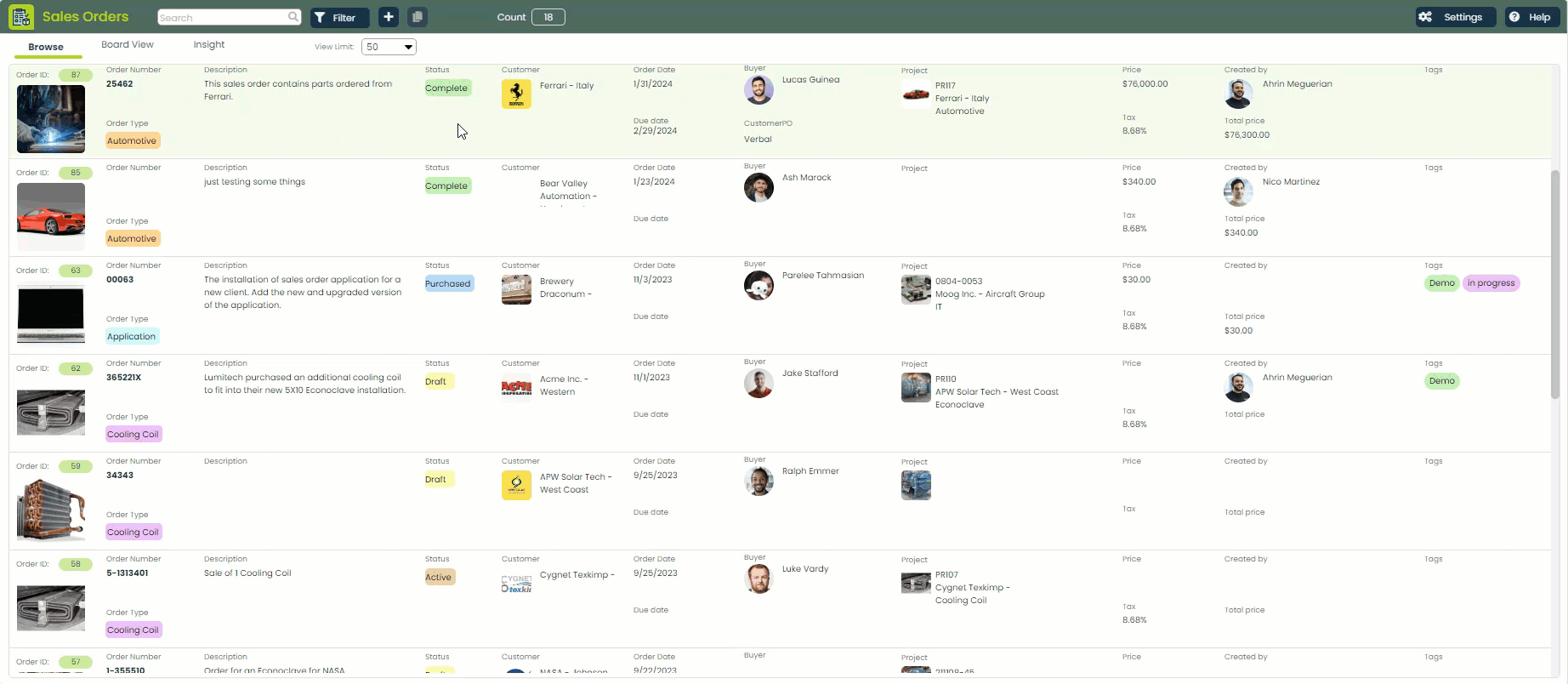
Let’s get started
To open the Sales Orders app, navigate to the Operations category in the main navigation bar and select Sales Orders.
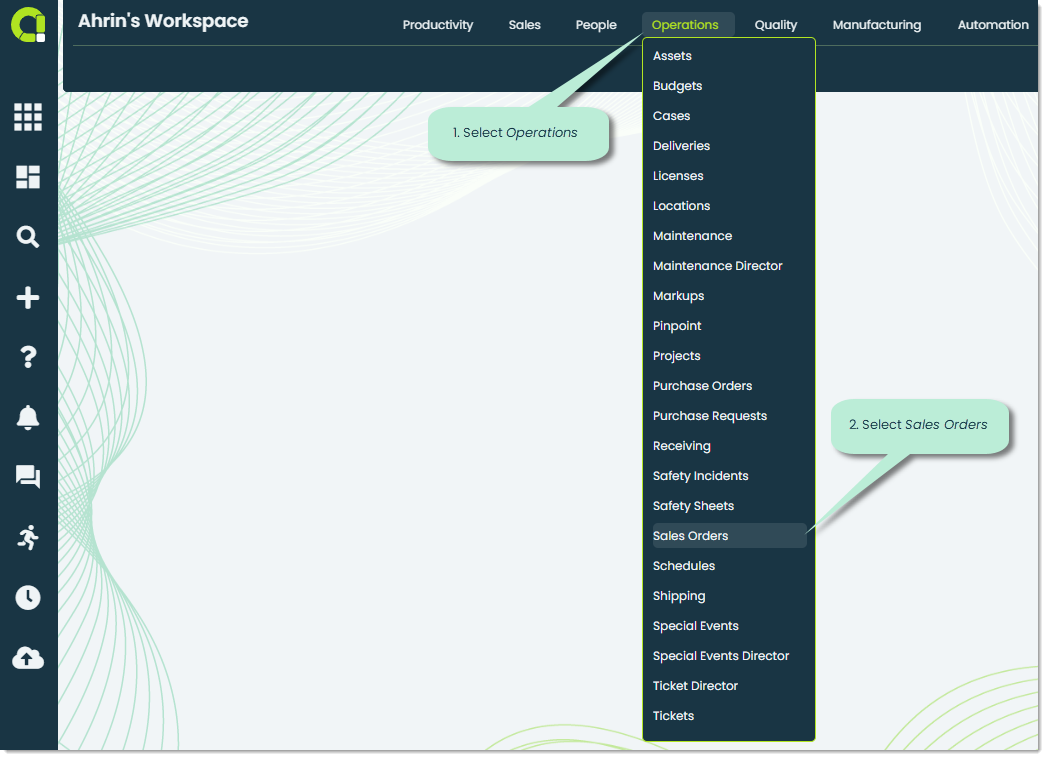
Upon entering the app, you’ll be shown the default Browse tab, where you can view a complete list of your organization’s existing sales orders.
Note: If this is your organization’s first time using Sales Orders, this tab will be blank.

Board View – The Board View tab displays a Kanban-style display of sales orders grouped by their type. As an example, sales orders with the type “Econoclave” can be found in the Econoclave column. Board view gives you a clear picture of how sales orders are moving along- from when they are initiated to when they are completed.

Insights – Insights are a great way to analyze data collected from your organization’s sales orders.

How to create a sales order
To add a new sales order, press the + icon at the top of the app screen.

This will bring up the Add Sales Order popup, where you can begin to fill in all the information regarding your sales order. Let’s go over the fields within this popup.
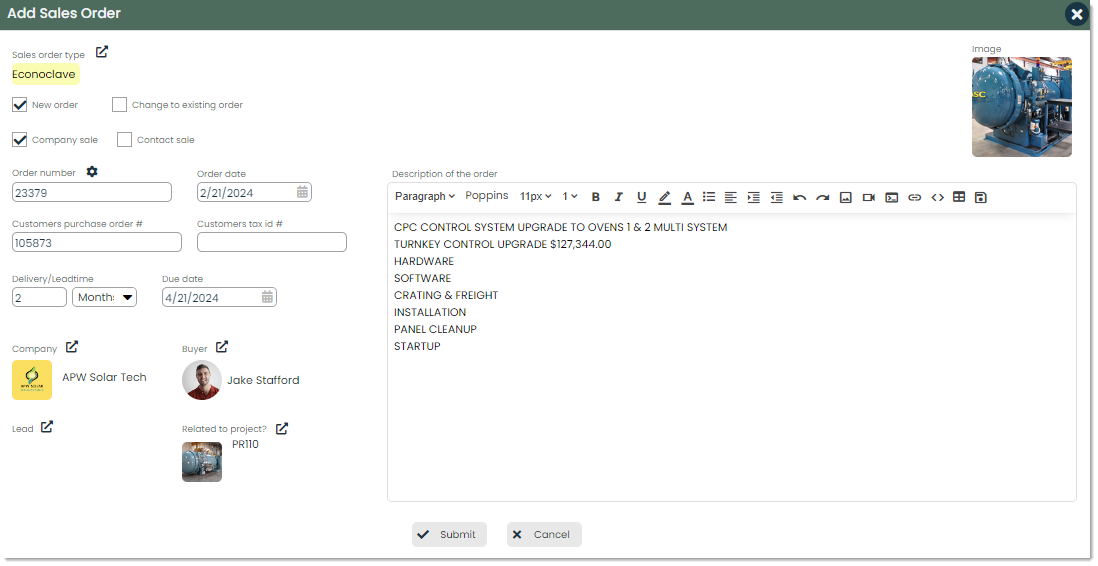
Sales order type – You can categorize the sales order you create by indicating its type. With types you can organize your data in a fully flexible, customized way that suits your business. For example, a sales order associated with the a project focused around an econoclave, could be given the type “Econoclave.” For more on types please check out Using Types.

Order number – The Order number is a unique identifier that you can assign to each sales order created by your business. Order numbers are typically sequential , however you can click on the cog icon if you wish to change the numbering system for your sales orders.

Order date – In Order date you can define the date on which a sales order is created or initiated by a customer. Establishing an accurate timeline is a crucial part of scheduling deliveries, tasks and overall inventory management. You can select this date by clicking on the small calendar icon and selecting the specific day or by manually typing the date in the provided text box using the DD/MM/YYYY format.

Customer’s purchase order # – The Customer’s purchase order # refers to written confirmation that is issued by a customer to detail their intent to buy specific products or services from your company. Purchase Order reports typically include descriptions, quantities, prices of goods or services, and the terms of sale.

Customer’s tax ID # – The Customer tax ID # is a unique number assigned to businesses or individuals by authorities for taxation and identification purposes. Businesses utilize this ID to track and report sales transactions, calculate tax liabilities, and comply with regulatory requirements related to taxes. You can enter this value by inputting the customer’s tax id into the provided text box.

Delivery/Leadtime – The Delivery/Leadtime of a sales order refers to the time it takes your organization to complete the order from start to finish. This includes processing, production, shipping & handling or any other additional actions taken for the customer to receive their product or service. You can specify a numerical value and whichever unit you require within this field.

Due Date – The Due Date can be directly calculated from your provided data in Delivery/Leadtime or be manually inputted using the provided calendar picker.

Company – In the context of Sales Orders, the Company refers to the entity that is initiating or fulfilling the transaction. You can define the Company by clicking on the external link icon and selecting from your organization’s company contact list.

Buyer – The Buyer is the individual within the company organization who is purchasing the goods or services. Similar to the Company field, you can select the contact of the buyer by clicking on the external link icon.

Lead – Leads are potential sales opportunities or prospects that have shown interesting in a company’s products or services but have not yet made an official purchase commitment. Within Appward, Leads typically represent a contact or organization that has expressed interest or demonstrated a need for a specific product or service. Leads are generated within the Leads app and can be directly imported into a sales order by clicking on the external link icon and selecting from your organization’s lead list.

Related project – The Related project field indicates the specific project with which a sales order is associated with. You can select from a list of project generated from the Projects.

Viewing and managing a sales order
To view the details of an existing sales order, simply click on the record to open up its details flyout.

This will bring up the details flyout, where you can view and manage all the details of a sales order, as well as utilize many of the robust features built in.
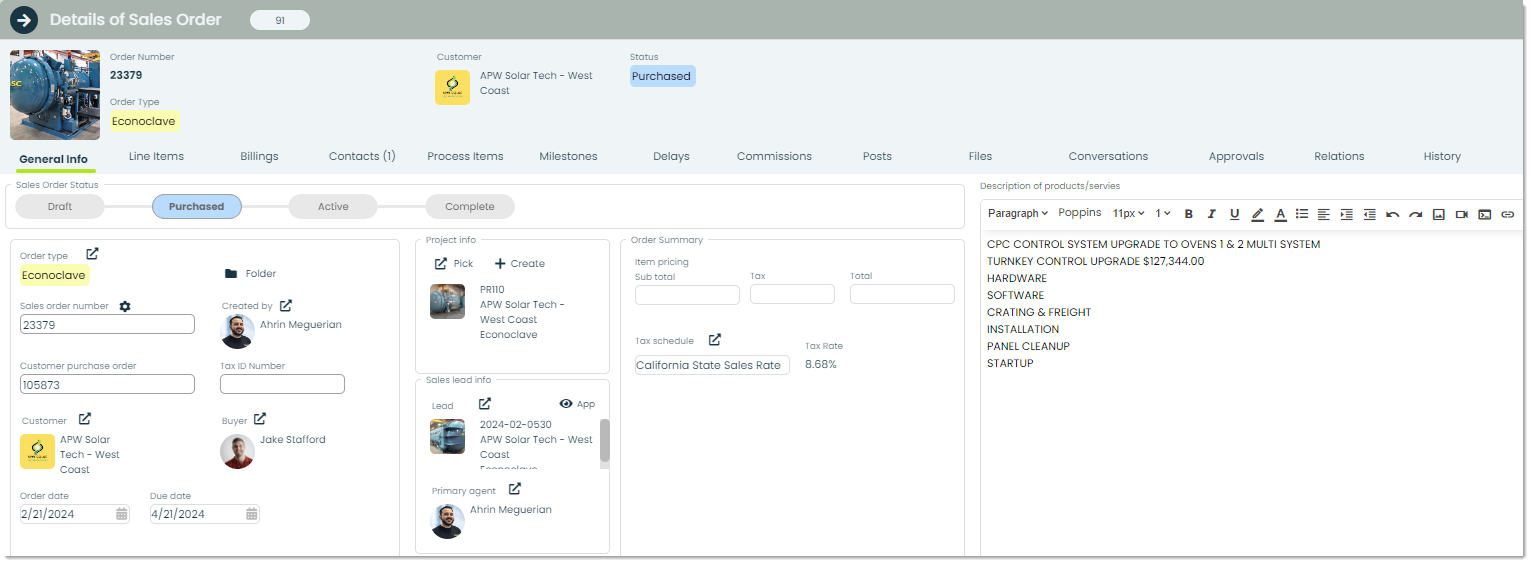
Sales Order Status – During the planning and execution of a sales order, you can track its progress through four distinct stages:
- Draft: The sales order is currently in draft mode, indicating that it is being created or edited and not ready to be public.
- Purchased: The goods or services specified in the sales order have been successfully purchased.
- Active: The sales order remains active, indicating that there may be long term ongoing transactions.
- Complete: The sales order has reached its final stage and is marked as complete, indicating that no further actions or steps are necessary.

Project Info – This field is where you can select a specific project that relates to your sales order. To link a project, simply click on the external link icon and choose from a list of available projects within your organization’s Projects app. Alternatively, you can create a new project by clicking on the “+ create” icon. This action will automatically populate the new project with the same details as the existing sales order. For more on how projects work, please check out Getting Started with Projects.
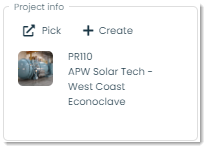
Sales lead info – You can manage the details of a linked lead within the Sales lead info section.
- Lead: Here, you can link a converted Lead (a customer or client who has shown interest in your products or services) from your Leads app.
- Primary agent: The Primary agent is the individual contact responsible for managing the sales lead. This individual typically follows up with the lead, provides assistance, and guides the customer through the sales process from start to finish.
- View in Leads app: If you need to edit the details of a lead, you can edit the record by click on the eye symbol which directly takes you to the record within the Leads app.
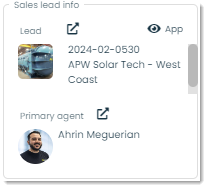
Order Summary – In the Order Summary section, you can view the financial details of a Sales Order.
- Sub total: The subtotal is the total cost of the items or services included in the sales order before taxes, discounts, shipping and other additional charges are added.
- Tax: The tax refers to the amount charged by tax authorities.
- Total: The Total represents the final amount paid by the customer, including the subtotal, taxes, and all other applicable charges.
- Tax schedule: The Tax schedule outlines the specific tax rates and rules applied to the products or services in the sales order. This rate can change depending on where the sale of goods takes place.
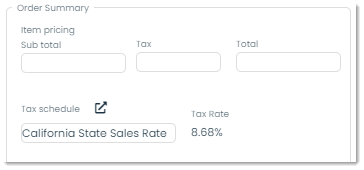
How to add line items to a sales order
Line items in a sales order refer to individual products or services that are listed separately within the order. Each line item includes specific details such as the product or service description, quantity, unit price and any applicable discounts or taxes.
To add line items to an existing sales order, navigate to the Line items tab within the details flyout of a record and click on the + icon.

How to add billings to a sales order
Billings are essentially the invoices to the customer for the goods or services ordered. To add billings to a sales order, navigate to the Billings tab within the details flyout of a sales order and click on the + icon.

Viewing contacts for a sales order
To view the contacts associated with a sales order, you can navigate to the Contacts tab within the details flyout of a sales order. You can also link new contacts to the order by clicking the + button.

How to add Milestones & Delays to a sales order
You can track and manage all of the significant milestones and delays of a sales order for full visibility into its progress.
Milestones: Milestones are key points or achievements within the sales order process that mark progress or significant events. These milestones can vary depending on the nature of the sales order, the complexity of the transaction and the requirements of the customer or the company. Some common milestones in a sales order process may include:
- Receipt of the order: When the sales order is initially received from the customer.
- Order confirmation: When the order details are confirmed and any necessary adjustments are made.
- Production or procurement: When products are manufactured or procured to fulfill the order.
- Shipment: When the products are shipped or delivered to the customer.
- Installation or implementation: For orders involving services or complex products, milestones may include installation or implementation stages.
- Acceptance: When the customer accepts the products or services delivered, indicating satisfaction with the order.
Delays: Delays occur when there are disruptions or obstacles that prevent the sales order from progressing according to the planned timeline. Delays can stem from various factors, including:
- Production issues: Problems with manufacturing or sourcing materials may lead to delays in fulfilling the order.
- Shipping or logistics delays: Issues with transportation, customs clearance, or unexpected events (e.g., weather conditions, strikes) can delay the delivery of products to the customer.
- Technical difficulties: For orders involving installation or implementation of complex systems, technical challenges may arise that prolong the process.
- Customer-related delays: Delays may occur if the customer requests changes to the order, experiences financial issues, or is unavailable for key decision-making steps.
- Internal process delays: Internal factors within the seller’s organization, such as resource constraints, communication breakdowns, or administrative delays, can also contribute to delays in the sales order process.
To add milestones or delays, you can use the Milestones and Delays tabs, respectively.

How to add commissions
Commissions in terms of sales orders refer to the compensation earned by sales representatives or agents for their role in securing and completing a sale. Commissions are typically based on a percentage of the total sales value or on a fixed amount per sale and are often used as a motivational tool to incentivize sales performance. To add any commissions and calculations of what those amounts are, you can use the Commissions tab.

Advanced Search and filtering
To make finding your sales orders easier, Appward provides searching and filtering features. These can be found at the top of the app.

For Sales Orders, you can search by any of the following criteria:
- Sales Order ID
- Order number
- Order status
- Customer company name
- Customer company division
- Order type
- Buyer name
After you type something in the search bar, press Enter to search.
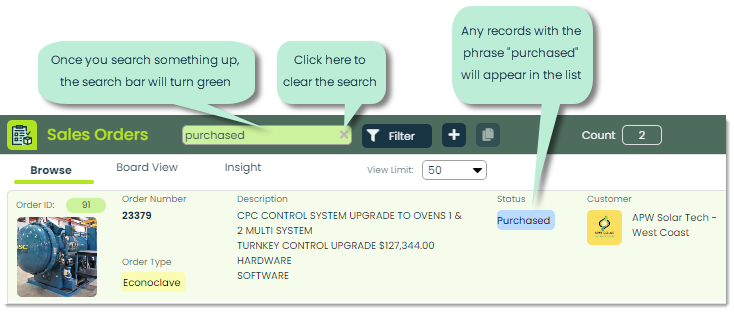
Additionally, you can use advanced searches which are more precise in what you want to find. Advanced searches use a format of “Field=Value” like the following example.
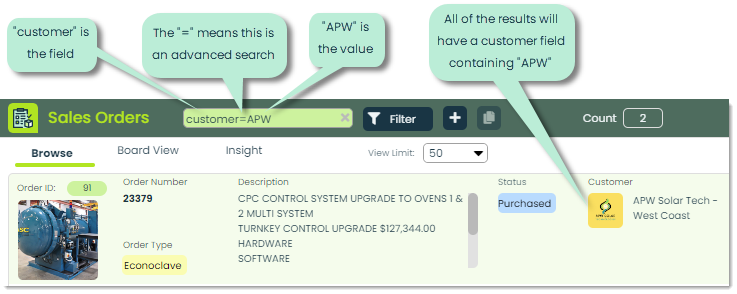
With Sales Orders, you can use the following keywords for your advanced searches. We’ve provided some examples as well.
- SalesOrderID, SalesOrder or ID (salesorder=91)
- Type or T (type=econoclave)
- Customer or Cust (customer=appward)
- Status or S (s=purchased)
- OrderNumber, Order or OrderNum (ordernum=23379)
- Buyer, BuyerName or Name (buyer=jake stafford)
- Project or P (project=pr110)
Note: Searches are NOT case sensitive, so you don’t need to worry about capital letters.
In addition to searches, you can choose from the following filters to narrows results by clicking the Filter button.
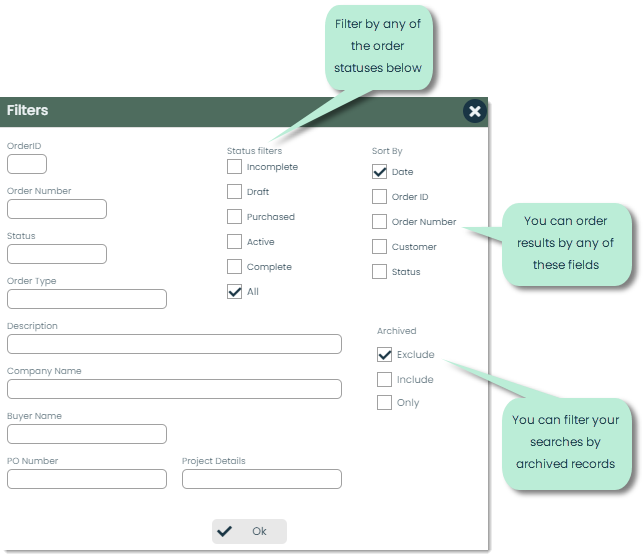
Frontline features of Sales Orders
Posts – In Appward, a post is a comment that’s open for likes and direct replies from other members of your organization. It fosters engagement and interaction among users within the context of the specific Sales Order.

Files – In the Files tab, you can upload essential documents to your sales order records. This functionality enables you to add multiple files and conveniently access them through an integrated document view. This provides you with a seamless method of incorporating relevant documents within your organization’s sales orders.

Relations – You can include related records from other apps directly in the Relations tab. Simply click on the + icon and click on the record from any app that you need to associate with the current sales orders record. Leveraging relations offers a convenient way of consolidating all relevant information involving a sales order in one centralized location.

History – In the History tab, you can access an activity log associated with the Sales orders you’re currently viewing. This log shows you a chronological list of changes, including the date, description of activity, author of the change, and the name of the application where the change was made.

